33 spectacular photos from the Astronomy Photographer of the Year shortlist
Zoë Ettinger

- The Royal Observatory at Royal Museums Greenwich (RMG) in London, England, just announced its shortlist for its Astronomy Photographer of the Year competition.
- The categories include "Aurorae," "Galaxies," "Our Sun," "Our Moon," "Skyscapes," "Stars and Nebulae," and "Young Astronomy Photographer."
- The competition received 5,200 entries from professional and amateur photographers from almost 70 countries around the world.
- The winners of the competition will be announced on September 10, 2020, and the photos will be displayed in London's National Maritime Museum from October 2020.
London's Royal Observatory has announced its shortlist for its prestigious Astronomy Photographer of the Year competition, and the photos are out of this world.
Multiple photos featuring the night sky, planets, stars, galaxies, and aurorae made the shortlist. This year's competition has a new award, the Annie Maunder Prize for Image Innovation, which is awarded to the person that can "transform images already captured and display the wonders of the universe in a fresh light," according to RMG.
The competition allows adults to enter all categories. Photographers under 16 can submit photos for the Young Astronomy Photographer category.
The overall winner of the competition wins £10,000 (about $12,570), and in each category, the winner receives £1,500 (about $1,880), the runner-up receives £500 (about $628), and the highly commended gets £250 (about $315).
Take a look at the stunning shots from the Astronomy Photographer of the Year Shortlist 2020.
Phil Harper, from the UK, was shortlisted in the Aurorae category for his photo of a geyser in Iceland with an aurora.

"This shot shows the famous Geysir of Iceland preparing to blow with the aurora behind it," according to RMG.
Ben Bush, also from the UK, was shortlisted in the same category for his image of an aurora over the Vestrahorn Mountains in East Iceland.

"The photographer describes this as a truly awe-inspiring experience and one he feels blessed to have witnessed and captured on camera," according to RMG.
Elena Pakhalyuk, from Ukraine, took this magical photo of the Northern Lights.
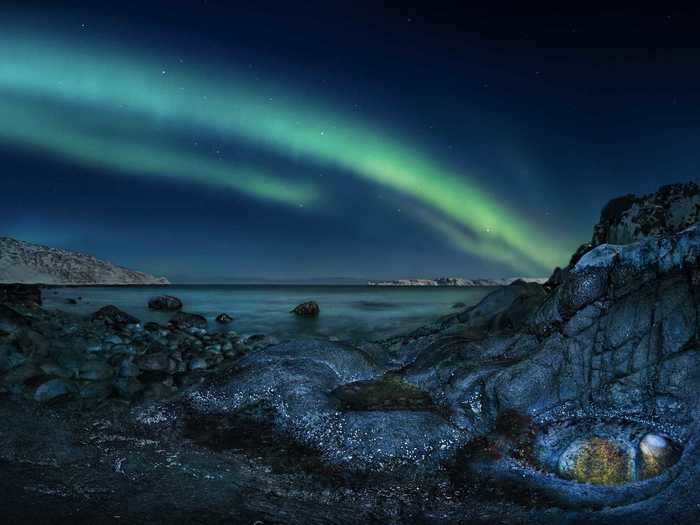
It was shortlisted in the Aurorae category.
"Trying to capture how ordinary things can take magical forms under the lights, the photographer selected and lit this rocky outcrop and waited for the aurora to work its magic," according to RMG.
Andreas Ettl, from Germany, captured an aurora over Hamnøy, Norway.
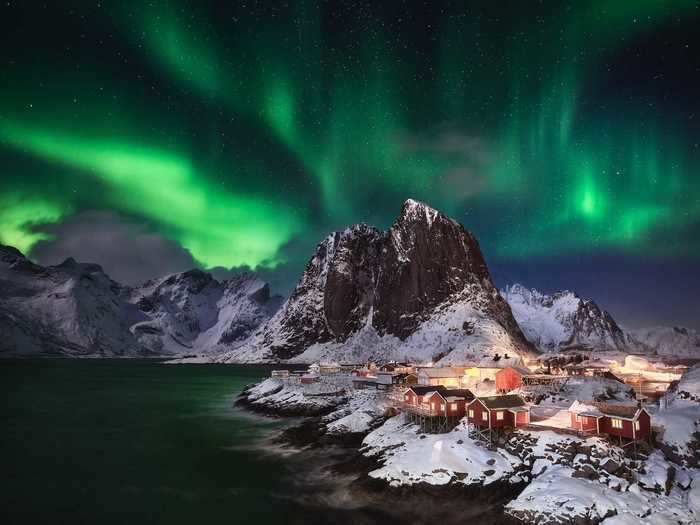
It was also shortlisted in the Aurorae category.
"The photographer waited patiently in his car for the light show to begin, and on the first sign of the aurora borealis in the sky, he set up his camera at this famous overlook of the idyllic fishing village, Hamnøy," according to RMG.
Louise Jones, from the UK, took a breathtaking photo of Kynance Cove under the Milky Way in Cornwall, England.
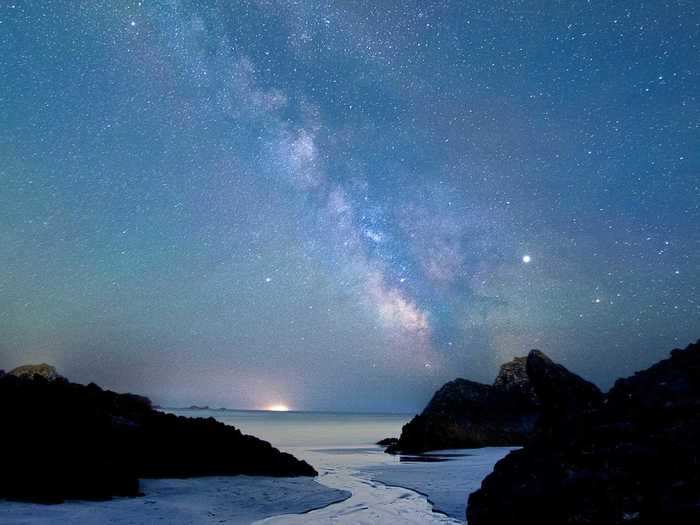
She was shortlisted in the Best Newcomer category.
"This image is only the photographer's second attempt at shooting the Milky Way. It shows our galaxy over Kynance Cove in Cornwall, a beautiful spot with dark skies. It was taken on a cold, but fabulous night under the stars," according to RMG.
Vinicius Martins, from Brazil, created a composite image of his best images of the solar system.
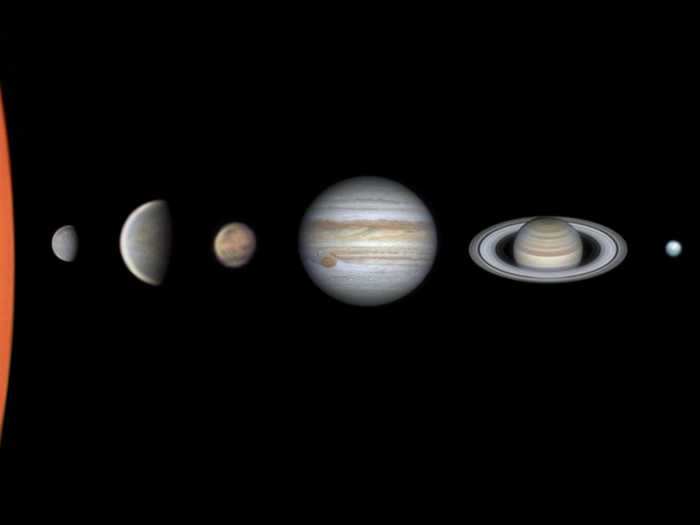
He was also shortlisted in the Best Newcomer category.
"This image is a composition that the photographer made using their best images of the solar system. The individual images were taken between July 2019 and February 2020. All images were obtained using the same planetary imaging method and combined," according to RMG.
Terry Robinson, from Canada, was shortlisted in the Galaxies category for his photo of the Sculptor Galaxy.

"[The Sculptor Galaxy] is an intermediate galaxy located within the constellation Sculptor and is one of the brightest spiral galaxies visible to us. It is also one of the dustiest and currently undergoing a period of intense star formation," according to RMG.
Martin Pugh, from Australia, was also shortlisted in the Galaxies category for his image of the Volans constellation.

"The photographer captured three hours of hydrogen and it was enough to accentuate the star birth regions occurring in the galaxy," according to RMG.
Rui Liao, from China, submitted this enchanting photo of the Triangulum Galaxy.
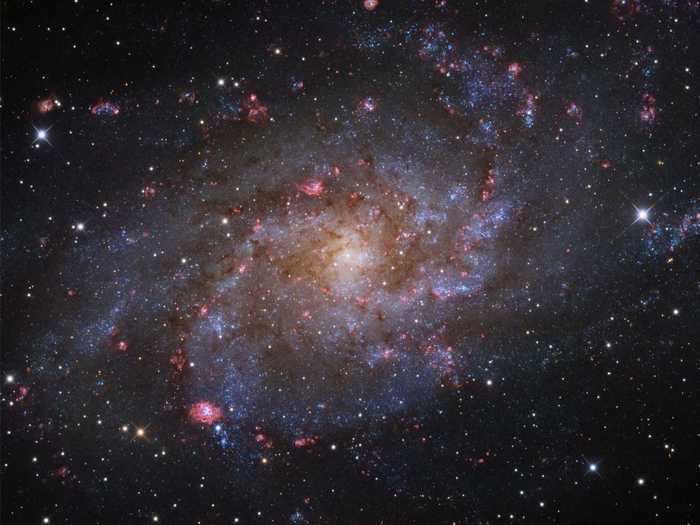
He was also shortlisted in the Galaxies category.
"This sharp image shows off M33's blue star clusters and pinkish star forming regions along the galaxy's loosely wound spiral arms," according to RMG.
Kirsty Paton, from the UK, took years to capture this image of her dog in front of the moon.
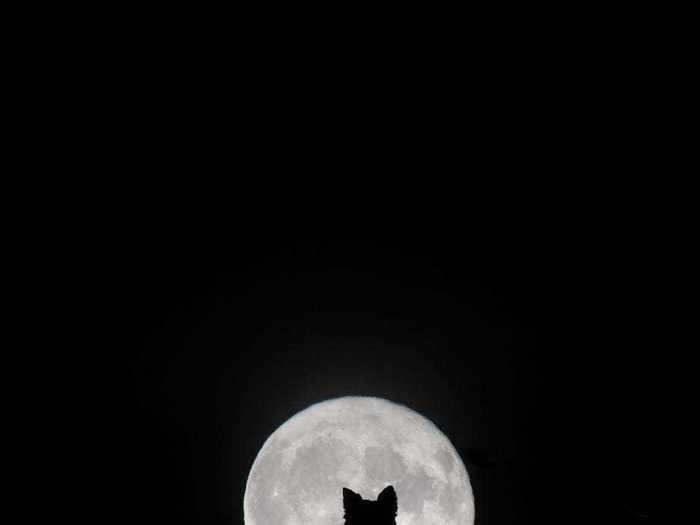
It was shortlisted in the Our Moon category.
"This charming shot was three years in the making. The photographer struggles to get her dog to sit still for a photo at the best of times. Adding total darkness meant that she needed the help of a close friend to tame the werewolf and finally capture the image," according to RMG.
Mathew Browne, from the UK, took this spectacular photo of the Shard building in London in front the moon.
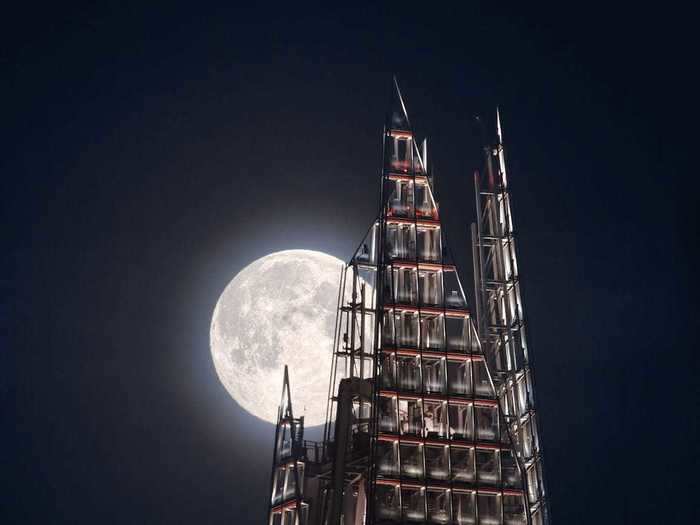
This photo was also shortlisted in the Our Moon category.
"After three failed attempts, the photographer finally got to shoot an image of London's iconic Shard skyscraper with a full moon behind it. The moon races through frame meaning the photographer only had a few minutes to capture the shot," according to RMG.
Richard Addis, from the UK, was shortlisted in the Our Moon category for his image of a crescent moon.

"This image of the moon at 39% illumination was captured through eleven videos of different areas, which were stacked and then stitched together. The saturation process revealed the mineral compositions in the lunar basalts on the surface," according to RMG.
Andy Casely, from Australia, captured the moon in front of Saturn.
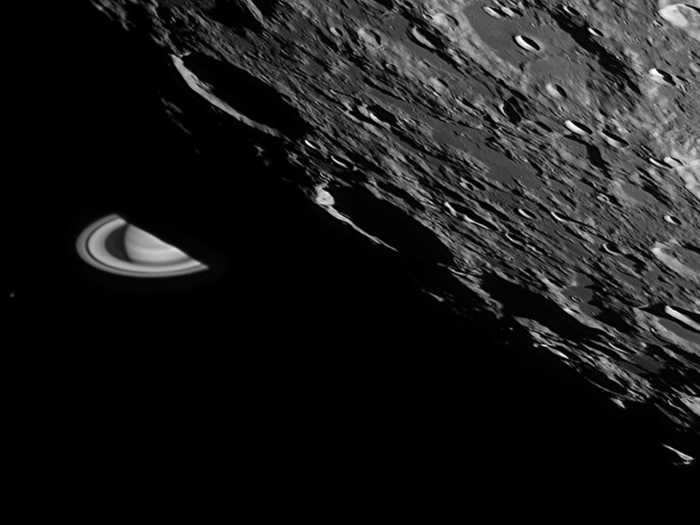
He was shortlisted in the Our Moon category.
"This is an image the photographer has long wanted to catch; the contrast of a big far away planet against the sharp details of the nearby moon," according to RMG.
Sebastian Voltmer, from Germany, was shortlisted in the Our Sun category for his image of a solar eclipse in Chile.

"The 50th Anniversary of ESO's La Silla Observatory culminated with a breath-taking and very clear total solar eclipse. In a very long process, the photographer calibrated, aligned and stacked 96 frames together, revealing the streamers and the faint corona," according to RMG.
Alastair Woodward, from the UK, captured a terrifying, active region of the sun.

This image was also shortlisted in the Our Sun category.
"This image shows an active region (AR2741) that was visible on the solar disc in 2019. The visible sunspot in the centre of the image is dissected by a light bridge," according to RMG.
Elena Pakhalyuk, from Ukraine, was also shortlisted in the Our Sun category for her manipulation of an image of the sun.

"The photographer was inspired to imagine what the Crimean peninsula would look like in the distant past, when thousands of volcanoes erupted on Earth. She used lighting and long exposure to illustrate this," according to RMG.
Dai Jianfeng, from China, captured this shot of the Milky Way above Easter Island.
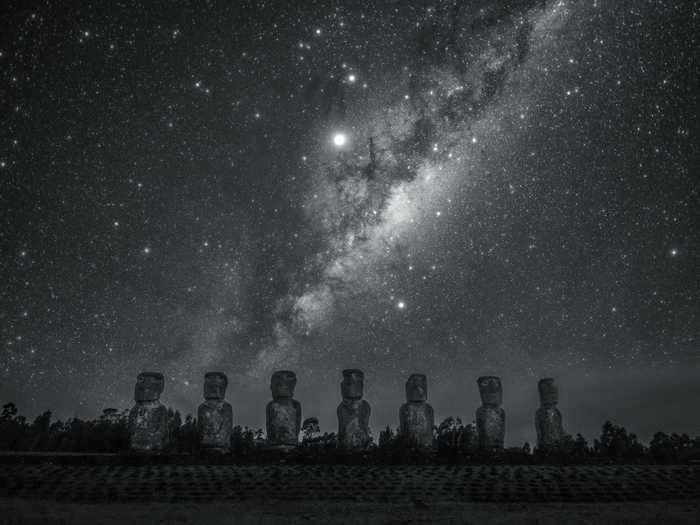
It was shortlisted in the People and Space category.
"The site has seven Moai, all of equal shape and size, and is also known as a celestial observatory that was set up around the 16th century. The shot highlights the central bulge of the Milky Way, the constellation Scorpio, as well as the planets Jupiter and Saturn," according to RMG.
Nicolai Brügger, from Germany, was also shortlisted in the People and Space category for his image of the night sky over Füssen, Germany.

"After a long hike and a little bit of climbing to the top of the mountain, the photographer was able to see the Milky Way. He only had five minutes time to take the panorama shot before the clouds moved," according to RMG.
Mohammad Sadegh Hayati, from Iran, took this image of himself in front of the night sky.
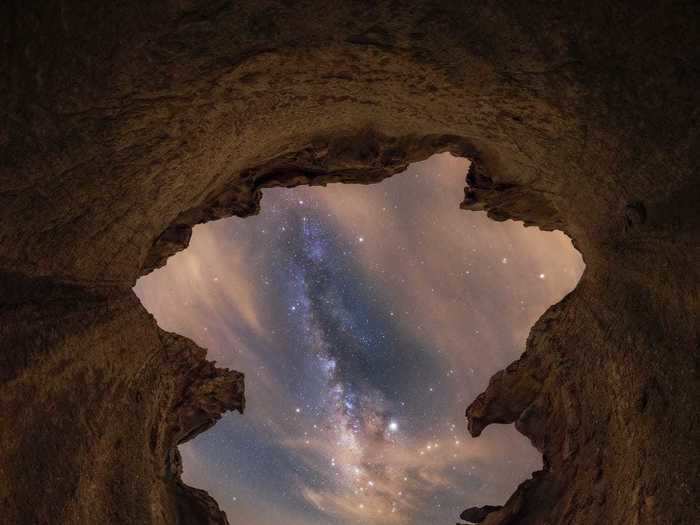
He was shortlisted in the People and Space category.
"On one of the many hiking trails along the coastline, the photographer discovered this incredible lookout. The scale of the vista encouraged the photographer to capture a 360 degree panoramic image of the entire sky using 60 15-second exposures," according to RMG.
Jennifer Rogers, from the UK, captured this serene photo of a fishing cove in Cornwall, England.
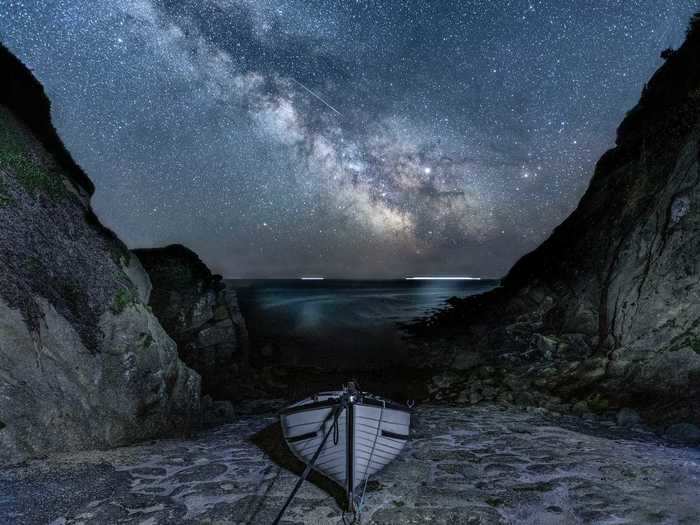
It was shortlisted in the People and Space category.
"Porthgwarra is a sheltered fishing cove in the west of Cornwall and the U-shape of the narrow cove is perfect for framing the Milky Way. There was likely to be a boat in the cove but the photographer was very fortunate to find it perfectly positioned in the centre of the old slipway," according to RMG.
Jay Evans, from Australia, was shortlisted in the Skyscapes category for his photo of the old Lithgow Blast Furnace in Australia.

"The incredible site of the old Lithgow Blast Furnace has been restored as a heritage icon in the area reflecting on the past history of the beginnings of the iron and steel industries in Australia. With some prior planning, visiting at night provides the mesmerising opportunity to capture the galactic core in the Milky Way as it passes overhead," according to RMG.
Bryony Richards, from the US, was also shortlisted in the Skyscapes category for her photo of Little Redfish Lake in Idaho.

"Years ago, before over-fishing, Little Redfish Lake was called as such due to the vast numbers of salmon turning the lake a red color. The red coloration is no longer seen because of salmon, but the color of sunsets and airglow during the night still turn the waters a vibrant red," according to RMG.
Bryony Richards was shortlisted a second time in the category for her photo of the Cave of the Wild Horses in Utah.

"Located in the heart of the desert in Southern Utah, the Cave of the Wild Horses, with its copious wildlife, petroglyphs, rock varnish, and framed view of the summer Milky Way in its entrance, makes for a fairy-tale place to take astrophotographs," according to RMG.
Jake Mosher, from the US, captured this incredible image of the night sky over Yellowstone National Park.
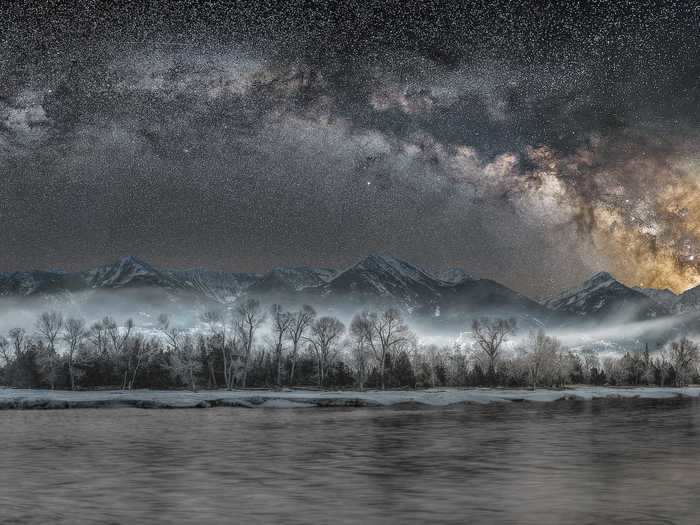
It was also shortlisted in the Skyscapes category.
"Shooting this panorama scene, while nighttime fog hung low over riverside cottonwood trees and the distant mountains of the Absaroka Beartooth Wilderness glowed from the light of countless stars, the photographer felt that he was able to capture a connectedness between this world and the one above," according to RMG.
Michael Zav'yalov, from Russia, took this photo of fog over a bridge at night.
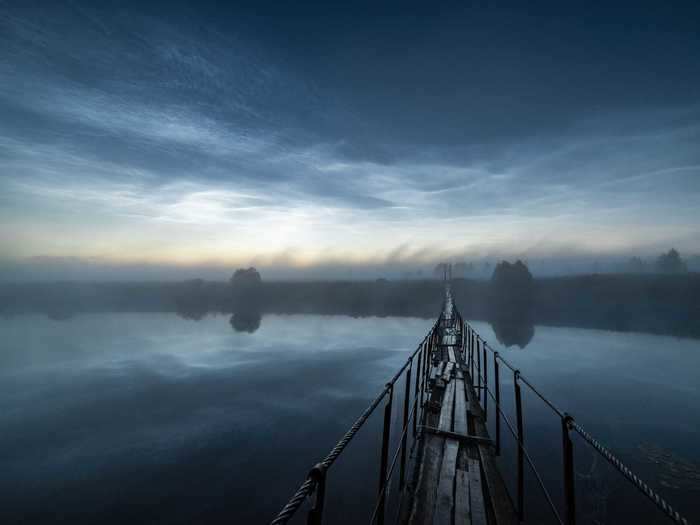
It was shortlisted in the Skyscapes category.
"The photographer had to wait, drenched on a rickety bridge until the thick fog had cleared. He was rewarded with noctilucent clouds in the sky, the outlines of which were reflected in the mirror of the calm river," according to RMG.
Marcin Zajac, from the US, was also shortlisted in the Skyscapes category for his image of the Milky Way over Kiama, Australia.

"Once the sun set, the photographer made his way into the cave and waited for a few hours for the core of the Milky Way to appear. Being unfamiliar with the southern sky, the photographer was surprised to also see Jupiter appear soon after," according to RMG.
Ignacio Diaz Bobillo, from Argentina, was shortlisted in the Stars and Nebulae category for his image of Thor's Helmet, a nebula.

"In this particular case, the photographer went back to an image he did last year, and added 19 hours of data to complete a 25-hour integration. It is a bicolor narrowband image of a well-known nebula, which is sculpted by a central Wolf-Rayet star," according to RMG.
Martin Pugh, from Australia, captured the Statue of Liberty nebula.
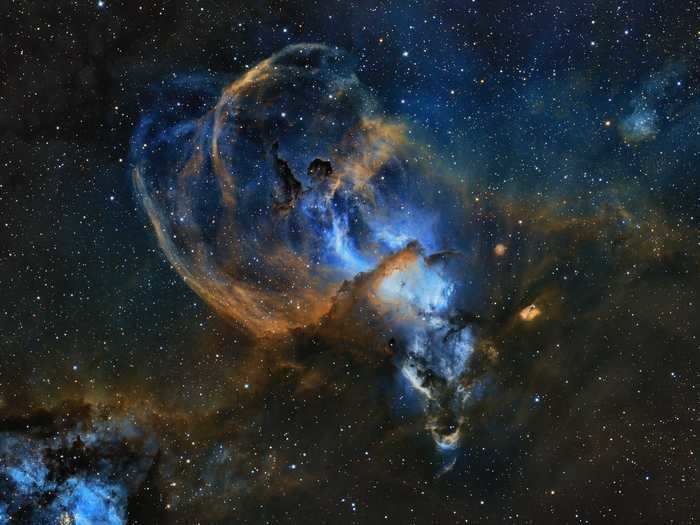
It was shortlisted in the Stars and Nebulae category.
The image was "photographed using narrowband filters to accentuate the energy levels occurring in each emission line, sulphur was mapped to red, hydrogen to green and oxygen to blue," according to RMG.
Josep Drudis, from the US, took this majestic image of the Veil Nebula.
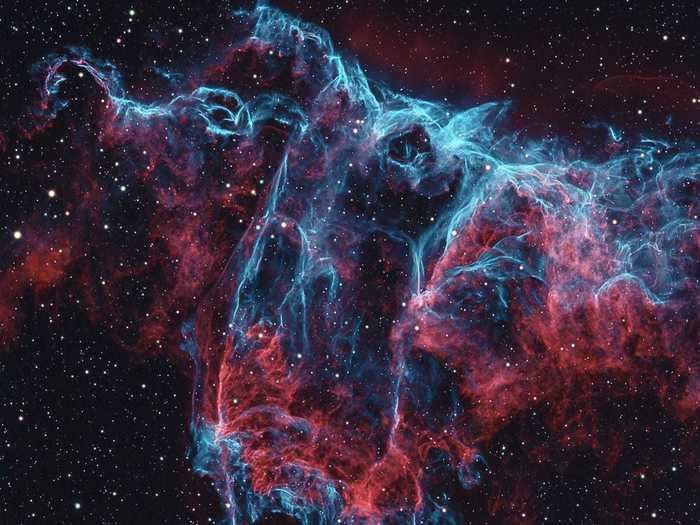
It was shortlisted in the Stars and Nebulae category.
"When a massive star explodes as a supernova it expels enormous amounts of materials, leaving behind one of the most beautiful examples of nebulae. This is the origin of the Veil Nebula, a large gas cloud in the constellation Cygnus, the Swan," according to RMG.
Mario Cogo, from Italy, was shortlisted in the Stars and Nebulae category for his image of the Rho Ophiuchi cloud complex.

"This image captures the photographer's favourite astrophotography field and one of the most vibrant, colourful nebulas in space," according to RMG.
Alexios Theodorov, from Russia, was shortlisted for the Annie Maunder Prize for his manipulation of a telescopic image of the M16 nebula.

"This entry tries to catch the feel of stargazing through basic optical instrument — a kind of Galileo's telescope. Special processing of the image includes converting to Lab, channel mixing, increasing contrast, and applying filters, with the aim of illustrating that images with limited color range may be as stunning as full-color ones," according to RMG.
Casper Kentish, from the UK, was shortlisted in the Young Astronomy Photographer category for his photo of clouds across the moon.

"The photographer wanted to get a good clear shot of the waxing crescent moon, but most of the time it was hidden by thick grey clouds. After waiting for things to clear up and successfully taking a couple of clear pictures he decided to keep shooting as the clouds covered the moon back up," according to RMG.
Qiqige (Nina) Zhao, from Australia, was shortlisted in the Young Astronomy Photographer category for a photo of star trails in Namibia.

"The image was taken while the photographer was staying in Sossus Dune Lodge, in the Namib Naukluft Park in Namibia. Situated in the tranquil and remote area, the lodge has the reputation of being the perfect place for stargazers," according to RMG.
READ MORE ARTICLES ON
Popular Right Now
Popular Keywords
Advertisement